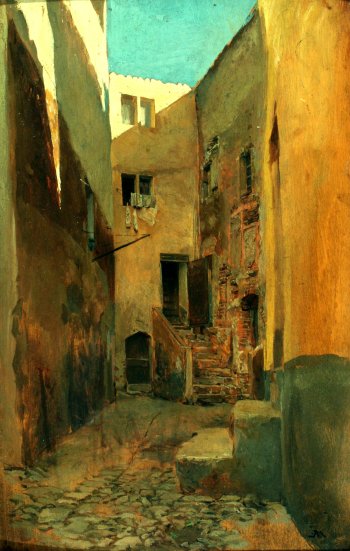|
A small group of paintings in the collection fall outside the category of sporting art and portraiture. Some of them are by non-British artists, and some pre-date the chronological period common to the bulk of the Bailey bequest, being 17th century. These assorted works have been gathered together here as a miscellaneous group.
Italianate Landscape
Two of this group are a pair of interesting landscape paintings by French 17th century artist, Gaspard Dughet. Being French and pre-18th century, Dughet is an unusual choice for Bailey, given the collector's general tastes and interests. The circumstances of their purchase are unknown, but Dughet continued to hold a high reputation at the turn of the century so these would have been valuable works to add to the collection.
Both works are characteristic of the artist in that they depict a 'classical' or 'Italianate' landscape (so-called because they make visual reference to Ancient Greece and Rome and its cultural heir, Renaissance Italy). Dughet produced a number of such works, taking inspiration from the landscape of the Roman countryside for his pictures. He was influenced by his brother-in-law, the famous and older artist Nicholas Poussin, whose name he took and is sometimes now known by - Gaspard Poussin.
Dutch Genre and History Painting
Apart from the works by the 17th century artist Ruisdael and the early 19th century marine painter Schotel, there are three other Dutch paintings in the collection, by Wijtmans and Israels, and a third unknown artist. Again two (the Wijtmans and the unknown work) are of the 17th century, the other (Israels)19th.
Wijtmans is a relatively little-known artist but his Lady Playing and Dog Dancing falls into the familiar category of genre painting, as it has come to be called. Genre painting was a favourite choice for Dutch 17th century artists; it was generally devoted to documentation of contemporary Dutch life and customs, often viewed within familiar interiors. It did not make use of the great myths and stories so often used by artists, but chose simply to capture mundane events of everyday life, such as the music-making and dancing pictured here. Generally, the people and places pictured by genre artists were socially fairly modest; the anonymous Dutch Peasant Seated at a Table is a good example of this. But a small group of these works, like the Wijtmans, show more lavish interiors and costumes. The Italianate architecture of the building glimpsed behind the figures, and the rich costume worn by the woman situate this image outside the lives of ordinary townsfolk. Nevertheless, the work makes no pretensions to elevated significance.
The Israels work is interestingly different in that it pictures a famous event of the 16th century, viewed from a distance of some 400 years. William the Silent (1533-84) became Prince of Orange in 1544, and in the 1560s led the Dutch rebellion against Spanish persecution of Protestants. He was assassinated, by gunshot, on the orders of Spain's King Phillip II. His eldest son, Philip William, seen here at his bedside, succeeded him to the throne. At the beginning of Israels' career, when this picture was painted, there was still a considerable taste for dramatic stories of tragedy and heroism from the past. In the long-term, however, Israels found straight genre painting more profitable and enjoyable, and devoted the main part of his career to picturing contemporary life.
Other works
Other works in this miscellaneous collection include two pictures by portraitists Joshua Reynolds and Thomas Lawrence. The Lawrence is a charming oil sketch of children gardening, while the Reynolds is one of a handful of images he produced of Cupid, the mythological messenger of love. In this version, Cupid smells a rose and holds what seems to be a diamond tiara in his right hand. These pictures of Cupid had no major narrative significance but simply allowed Reynolds to weave lightly erotic pictures out of images of a chubby boy-child.
In a quite different spirit are the works by David Roberts, Jean Charles Meissonier and Johannes Christiaan Schotel. They are all 19th century works. Roberts was a Scottish artist who travelled widely in the course of his career, producing many paintings of sites in Egypt and the Near East, as well as architectural interiors like this one. St Stephans Cathedral was an obvious choice of interior for an artist looking for dramatic scenes and spaces. It is a towering Romanesque and Gothic structure that stands in the centre of Vienna, richly ornamented outside as well as in. Roberts' early work as a stage-set designer seems to have partly conditioned his eye in the production of this work, and led to some deliberate spatial distortion; he has given the interior a dramatic entree and framed the central scene with the squat broad columns that arch broodingly low in the foreground. At ground level, wooden covers have been removed to reveal steps underground, presumably to the catacombs that lie under this cathedral and that hold the remains of more than 11000 dead.
Another small architectural scene, the Small Street in Antibes, is the work of Jean Charles Meissonier, a French late 19th century artist who can easily be confused with his far more famous father, Jean-Louis-Ernest, painter of battle scenes and historical genre. Meissonier junior was trained by his father, but little is known of his career. His unfinished study of a horse would have had an obvious appeal to Bailey, but like the Roberts work, it is unclear whether the Small Street in Antibes held any special sentimental appeal for the collector.
|
Click here to view all miscellaneous 
Jean Charles Meissonier, A Small Street in Antibes, oil on panel
|

